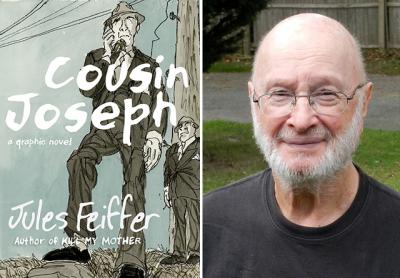Bare-Knuckle Ballet

“Cousin Joseph”
Jules Feiffer
Liveright, $25.95
Jules Feiffer, our brilliant East End neighbor, is acting badly again. And that’s great news.
“Cousin Joseph” is the second installment of Mr. Feiffer’s graphic novel trilogy, a lively (and decidedly deadly) film noir homage that follows on the hard-boiled gumshoe heels of his 2014 New York Times best seller, “Kill My Mother.”
This exciting prequel is filled again with Mr. Feiffer’s nostalgia for Depression-era tales, filled with detectives, dames, and sex. He also references violent union-busting, Red Scare tactics, media manipulators and sellouts, and Hollywood musicals.
A key character is a mysterious “uncle,” an anti-immigrant 1-percenter whose wealth infects everything and everybody from movie moguls to alleged law enforcers.
Sound familiar?
In unfolding this dark and gripping 1930s story, Mr. Feiffer masterfully alludes to the origins of our current 21st-century crisis of undue corporate influence resulting in media manipulation and a stalemated political process.
Highly expressive character drawings, in a palette dominated by sepia and other muted colors, animate events in an imaginative series of sequential poses. Mr. Feiffer’s restless artwork never bores, and always illuminates feelings, both emotional and physical.
The artist’s early experience in film animation (he won a 1961 Oscar for the short “Munro”) is evident in his lovingly staged balletic fistfights, which are seen from varied “camera” angles. His well-known graphic style — loose lines that coalesce into strong storytelling poses — are as evocative as ever. Rarely has gory bloodshed been so gracefully depicted.
The page layouts are consistently creative. A full page of two men conversing in an office becomes, in Mr. Feiffer’s hands, a cinematic traveling camera shot, with the men engaging in dialogue while moving in multiple phases of performance.
Sometimes the artist chooses to commit off-screen violence, as when a pro-union folk singer is roughly silenced. Thus, the imagination of the reader is stimulated, and becomes complicit in the act.
More often, Mr. Feiffer makes the reader’s “complicity” boldly direct. In one brilliant bit of staging, by merely turning a page, the reader is witness to a surprise execution.
Throughout the story, there are also numerous moments of warmth and subtlety to bind us to the characters and make us empathize with their dire situations. A single mother, Cissy Goldman (whose name evokes the anarchist Emma Goldman, and clearly establishes the character’s leftist bona fides), prepares a quick dinner for her preteen son, Archie, before she dashes off to participate in a dangerous strike at the local cannery.
In this two-page scene, Mr. Feiffer opens a world using succinct dialogue and judicious staging. The brief scene ends in a full-page drawing of tall, ample Mrs. Goldman in an overcoat, standing and hugging her son goodbye. The staging and characters’ poses are perfect: Cissy’s “smotherly” love presses Archie tightly against her.
Squirming uncomfortably, his worried expression is caused by her monologue as much as her bear-trap hug. For during this touching moment between mother and son, Cissy says these tender words: “If they leave me rotting in jail, you’ll be taken care of. The union has a strike fund. . . . Now give your momma a hug! They don’t give ya hugs in jail.”
What a wonderful counterpoint of earthy dialogue and a tender drawing to reveal the two characters’ relationship.
I can’t wait for “The Ghost Script,” the third and final of Mr. Feiffer’s trilogy.
John Canemaker, who lives part time in Bridgehampton, is an Oscar-winning animation filmmaker, professor and head of the animation program at N.Y.U.’s Tisch School of the Arts, and the author of 12 books on animation history. He curated the exhibition “Wish Upon a Star: The Art of Pinocchio” at the Walt Disney Family Museum in San Francisco, running through Jan. 9.
Jules Feiffer lives in East Hampton. He will talk about “Cousin Joseph” at Canio’s Books in Sag Harbor on Sept. 3 at 5 p.m.
